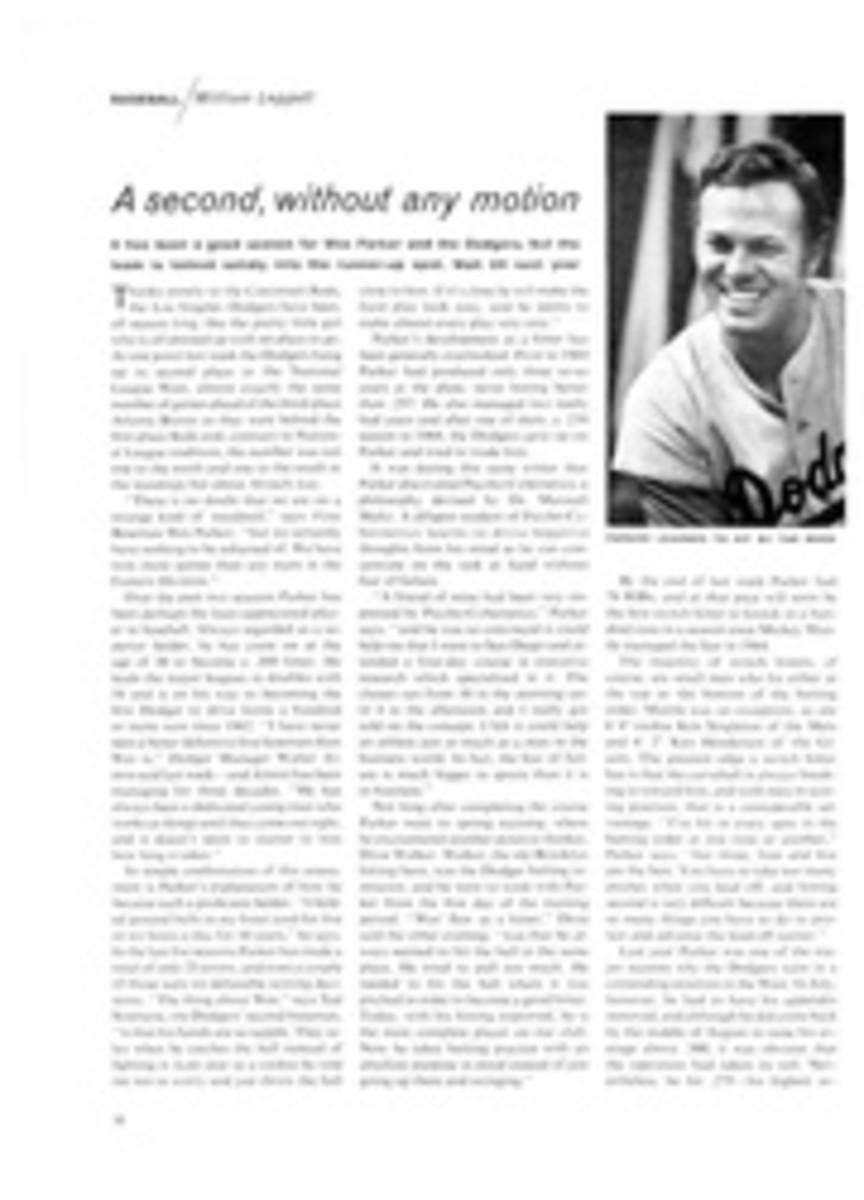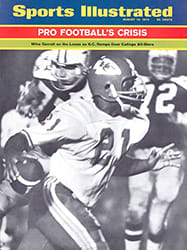
SPLASHY STRUGGLE FOR A TITLE
All right, class, today we will deal with some famous old American myths. Myth No. 1: the United States borderlines are formed by Canada, Mexico, some islands and two oceans. Myth 2: water polo is a game played by men riding horses in the water. Myth 3: the United States has lousy water polo teams. It is time to expose these myths.
The facts, revealed during last week's National AAU water polo championships in Long Beach, Calif., are that the U.S. boundaries actually are the Pacific Ocean, Mexico, Nevada, Arizona and Oregon. Sometimes known by its Indian name, California, this territory has produced every single water polo team that has qualified for the national championship. As for myth 2, there was indeed a time when most water polo players looked about as graceful as horses in water, but this has changed. Today's topflight player may have to be as big as a horse, but he also can lunge like a porpoise, balance the ball like a seal, stick to his opponent like a lamprey and—if necessary—fight like a barracuda. Finally, those who belittle the quality of American water polo delight in stressing that our only Olympic gold medal in the sport is dated 1904—the year we happened to be the only nation entered. But, judging by the performances in Long Beach's cavernous, $3.7 million Belmont Plaza pool, the game has a bright new future.
Valiantly undistracted by the unending tide of healthy, bikini-clad young females who flowed past the pool each day (must every California girl have a smashing figure?), these waves of sleek, husky young men kept their eyes on the goal and those 14 berths on the U.S. All-Star team departing soon for Europe.
When the foam finally settled after three furious days, that bright future seemed closer than ever: America's top team made it the hard way through the fiercest competition in years, including a wild overtime finale, before officials let anybody out of the water. The place was up to here in soaking-wet All-Stars.
Water polo is a combination of basketball, soccer, hockey and karate. Each team uses six field players and a goalie, who guards a cage 10 feet wide and three feet high. To spot teammates quickly through the spray, players wear blue or white caps. And to enhance future good hearing, protective ear cups made of hard plastic were recently added to the caps. The modern player must be a powerful swimmer. This was not the case when the game was founded in England in 1860. Pools were so shallow then that many players didn't swim at all, and the goalie often protected his net by the direct expedient of picking up an attacking forward and flinging him away.
Although water polo came to America in 1888, there were two distinct styles until the late 1930s: the international game, played with a hard ball and stressing slick passing and ball handling, and the American game, where these skills helped but where brawn and a shallow conscience were the primary requirements. Americans used a half-inflated soft ball that players were able to hide underwater (this is no longer allowed), igniting marathon wrestling matches and leading to the publication of a 1927 water polo manual featuring illustrations of such aquatic musts as the front stranglehold.
In one Eastern college pool bounded by a rope it was common practice to try and ensnare an opponent's neck in said rope. "Mostly as a joke, of course," wrote one historian, "because it is impossible to hang a man in the water." But, ultimately, the brutality of the American game lost its charm. And anyway, the European teams, especially those from Iron Curtain countries, still dominated the sport. Hungary has won five of the last eight Olympics. The best American finish was third place in 1932.
U.S. fortunes sank completely in the 1964 Tokyo Olympics when the team failed to get past the first round. The humiliation set off a dramatic series of changes that are still going on. Out went the traditional method of player selection in which the top club team was sent en bloc to the Olympics, often leaving behind outstanding players from runner-up clubs. In the new system, an All-Star group is formed into the national team. The first such team won the 1967 Pan-American Games in Winnipeg, earning the only gold medal the U.S. has ever won outside the country.
Nowadays training camps are operating, and in California alone the number of schoolboy water polo players is double the total of 1960. Nationally, the game's 13,000 competitors will soon swell with thousands of youngsters from newly organized Junior Olympics and recreation department programs.
Last week produced the first big bang in the sport's new explosion—and it was sooner than expected. "De Anza will win even if half their players drown," said the experts. Well, it was almost that bad. The De Anza Aquatic Club, based near San Jose at Cupertino, came to Long Beach as defending national champion. Coached by Art Lambert, a boyish-looking 34-year-old who also coached the 1968 U.S. Olympic team that won five of eight games for fifth place in Mexico City, De Anza includes three Olympic players and has a reputation as the best U.S. club team ever.
If not the best ever, De Anza surely must be the biggest. Even with 5'9" Olympian Gary Sheerer in the lineup, the starting unit averages 6'2" and 192 pounds. Last December Lambert took De Anza to Europe and won all 10 games on the tour. So, with all this going for De Anza, the tournament had promised to be fairly routine. But of equal interest to the club competition was the battle for the All-Star squad and the Olympic Committee tickets to a two-week European trip, including games against Hungary and Olympic champion Yugoslavia. This will be the first time a national team has toured in a non-Olympic year, another significant indication of the sport's new vitality in America.
An even better indication came where it was least expected—in the tournament itself. The second day of round-robin play had hardly begun last Saturday when every prechampionship assumption was blasted straight out of the water. In one of those contests which image-conscious officials tactfully describe as "physical, not rough, but, uhh, physical," Phillips upset De Anza 6-5.
Suddenly the team title was again a very interesting subject indeed. Phillips' victory threw the tournament into two days of new pandemonium, pressure and incredible tension as one team after another surged up, only to sink back.
Because Phillips is temporarily under strength this year, with two players absent due to military service and two others unable to leave their jobs, Coaches Monte Nitzkowski and Bob Horn built their lineup around the players from NCAA champion UCLA, where Horn coaches in winter, and stirred in two Olympic veterans, Stan Cole and Bruce Bradley.
De Anza also has lost one Olympic star to the military, but since it had beaten this same Phillips' team 11-2 in winning the Golden West Invitational three weeks earlier, the outcome seemed certain. Or it did until three goals by Eric Lindroth put Phillips ahead 3-1. De Anza Olympian Sheerer scored three of his own for a 4-3 lead, but Phillips rallied, again, and won 6-5.
Thus De Anza found itself no longer in control of its own fate. Even if it won all the rest of its games, De Anza could not win the title unless someone beat Phillips.
Come Sunday, someone did. Corona del Mar, a collection of exceptionally strong swimmers who have been grinding through two workouts daily since February, broke three tie scores to edge Phillips in another thriller 6-5.
Now the only undefeated team in the final round, Corona retained that status for just three hours, when De Anza came back to win a ferocious contest 8-7 and throw the tournament into a three-way tie. Phillips, Corona and De Anza, already exhausted, faced a grueling playoff round that would keep them in the pool for hours.
But De Anza did it. Weary and with every reason to feel waterlogged, the crew first beat Corona 8-4, and two hours later sank Phillips 10-9 to win its fifth national title in six years. But there was an added bonus in all the late excitement: the fact that the big boys had such trouble putting down the upstarts meant that there would be plenty of real All-Stars to make the tour. "We now have," sighed one tired coach, "a reservoir of the finest world-class players this country has ever produced."
If such high drama was a surprise, the high caliber of play was not. It reflected a meshing of factors—both in and out of the water—that bodes well for 1972.
Once again, for example, the American game is in distinct contrast with the European style. No, we didn't let the air out of the ball again. Quite the opposite. The American style has evolved from crude grappling to a wide-open game of speed, stamina and finesse.
American prospects also are improved by several important rule changes, all designed to speed up the game. But ironically, just when so many developments are enhancing the American outlook, water polo itself is facing a crisis of existence in the one event that is the raison d'√™tre for every player—the Olympic Games. The crisis stems from the way the game is refereed, and it was exacerbated by the fiasco in the 1968 Games, where the rough grab-and-hold tactics of teams like Russia resulted in 80% of the goals being scored on penalty shots. This has somewhat less spectator appeal than watching the Knicks and Lakers stage a free-throw contest for the NBA championship.
So it was only natural that, during the final game, when Russia and Yugoslavia staged a typically brutal—thus slow, thus dull—contest, all but 1,000 spectators walked out.
It was this walkout that apparently jarred the European hierarchy into adopting the American-advocated rules. But only time will tell if the new rules really solve anything, because in water polo the referee himself continues to have enormous discretionary power, probably more so than in any other sport.
Even worse, some nations seem to regard their referees as political emissaries. Art Lambert was shocked when, as the 1968 U.S. coach, he was asked by an Italian team official to arrange for American Olympic Referee John Felix to call few fouls in Italy's next game so Italy could build its goal average. In return the U.S. would get a good game from the next Italian referee.
Hoping to encourage acceptance of the new rules among European referees, Robert Helmick, the chairman of the U.S. Olympic and AAU Water Polo Committee, invited the president of the International Water Polo Referees Association, Alphonse Angella, to be a guest at the AAU meet. If he was impressed by the faster game, Monsieur Angella managed to contain himself.
"Yes," he said, "the faster game would mean an advantage for the Americans. But also they must improve their tactics."
Is the United States now on a level with the best European teams?
"No."
Pause. Oh?
"The Americans lack team play."
Translated, that could mean the Americans lack team play or it could mean the Americans should live so long if they think the old guard is about to let them burn up swimming pools and tear up the chlorine balance of power just because of some hot-rod new rules.
The national team chosen at Long Beach should be the first to know.
PHOTO
NEIL LEIFER
Swimming with strength—and size—the De Anza team (in blue caps) surged to victory.
THREE PHOTOS
NEIL LEIFER
Mixing in a touch of soccer in the save (above) and adding bits of down-pool blocking and a dash of dunk-your-opponent, all the players combined finesse with fast bursts of power.

